PinotFile: 6.14 January 29, 2007
|
Wild Men From West CountyMatt Kramer, New California Wine Growing Pinot Noir along the most western reaches of the Sonoma Coast might be regarded as pure folly to many, but the dedicated band of “wild men” who have accepted the challenge know that the fickle grape feels right at home here. This region is quickly becoming one of the epicenters of Pinot Noir in California. The Sonoma Coast AVA (American Vineyard Appellation) is the largest of the 13 AVAs in Sonoma County at 750 square miles. This cumbersome AVA was formed in 1987 primarily to allow certain wineries to include all of their scattered major vineyards within one boundary so they could use the “estate bottled” designation on their wine labels. The Sonoma Coast AVA is defined by its coolness, with no more than 2,800 degree days of heat during the growing season. It is sandwiched between the mountains and the Pacific Ocean, and with its high winds, daily fog, and cold temperatures, is a hostile environment only Pinot Noir could love. The vineyards are positioned either above or below the fog line or in microclimates where the wind blows off the fog. There are an endless number of mesoclimates and soil types in the Sonoma Coast AVA, but the common denominator is the coolness. The Sonoma Coast AVA extends from the Sonoma County border with Napa in Carneros to the east, to Marin County to the south, to the Pacific Ocean in the west, and to the Russian River Valley AVA boundary to the north (refer to map on page 2). It overlaps five other AVAs including the Sonoma part of Carneros, a sliver of Sonoma Valley, the western part of Chalk Hill, all of Green Valley, and most of the Russian River Valley. Because of the unwieldy immensity of the Sonoma Coast AVA, it has been unofficially subdivided into the “true” or “real” Sonoma Coast. This subdivision is roughly from Jenner in the south where the Russian River empties into the Pacific Ocean to Annapolis in the north and from the beaches to 5-6 miles inland including the first two ridges of the Coastal Range of mountains and the west slope of the third ridge. Besides Annapolis and Jenner, usually Ft Ross, Occidental and Freestone are included although all are south of Jenner. Eventually, the true Sonoma Coast will be broken into smaller AVAs. A small portion, the Ft Ross Seaview area, above 920 feet elevation, applied for its own AVA in 2003. Regardless of how it is currently outlined, the region is defined by its extreme coolness which makes ripening Pinot Noir before the Fall rains come a challenge. 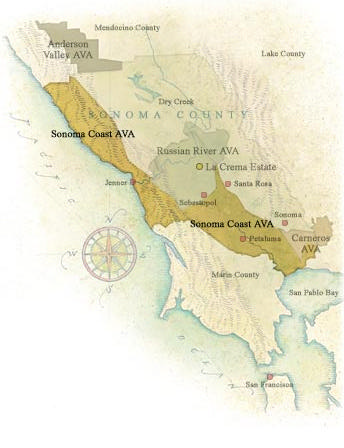 The price of land has gone from $4,000 an acre to at least five times as much in the last decade. The price is misleading and in reality much more expensive than the amount suggests because the landscape does not lend itself to farming. A winegrower might have to purchase 50 acres to get just 10 acres suitable for farming grapes. Much of the area is too hostile and too steep for grapevines. Another hurdle to farming here is the local residents, who although sparse in number, are quite rabid in their opposition to development in this region. Mike Bohan was the first to plant grapes in the true Sonoma Coast. In 1973, he developed a vineyard on Bohan Dillon Road which included Zinfandel, Pinot Noir, Chardonnay, and Riesling. To this day, the Bohan Ranch sells all of its grapes. The list of subsequent pioneers in the true Sonoma Coast region reads like a who’s who of California Pinot Noir. The names include Helen Turley and John Wetlaufer (Marcassin), Lee Martinelli (Martinelli), David Hirsch (Hirsch Vineyards), Bill Smith (W.H. Smith), Ted Lemon (Littorai), Walt and Joan Flowers (Flowers Winery), Mark Bixler and Steve Kistler (Kistler Vineyards), Ross Halleck (Halleck Vineyards), and Daniel and Marian Schoenfeld (Wild Hog). More recently, there has been considerable interest in the Sonoma Coast by several prominent Napa wineries including Caymus (Belle Glos), Pahlmeyer, Peter Michael, and Joseph Phelps (further information later in this issue on the Phelps project). David Hirsch was a visionary whose Hirsch Vineyard is synonymous with the Sonoma Coast. His remote vineyard on a high ridge overlooking the Pacific Ocean was planted in 1978. He bought 1,100 acres of land and planted about 68 acres to Pinot Noir. At the time, it was crazy to imagine than one could make a living growing grapes in this inhospitable region. In 1994, Ted Lemon (Littorai), Burt Williams (Williams Selyem), and Steve Kistler (Kistler Vineyards) became three of the first and most important purchasers of Hirsch Vineyard fruit. Today, his vines are among the few mature plantings of French-clone Pinot Noir in California. According to Rod Smith of the Los Angeles Times, “Wines made from Hirsch Vineyard fruit show that kind of resonant acidity to a greater degree than typical Pinot Noirs from Carneros and most of the Russian River Valley. They vibrate on the palate and fix the impressions with a kind of luminosity that reminds me of the quality of light in paintings by Rembrandt and Vermeer. Individual sites along the continuum make their own unique statements.” Crops in the true Sonoma Coast can be very small depending on the vintage. In 2005, for example, some vineyards were decimated by rain during bloom and several vineyards yielded less than 1/2 ton per acre. The main cause for this was poor set in the spring. Another difficulty is that the vines grow very slowly in the region, and it can take at least an extra year or two for a vine to advance from the initial planting to a productive phase. (five instead of three years as in other Sonoma regions). Anthony Austin, winemaker at Sonoma Coast Vineyards and resident of the Freestone area, has found it necessary to severely prune back his new estate Pinot Noir vines close to the ground, so as to achieve strong and more vigorous vine trunks in the future (at the expense of much back pain). What is distinctive about Sonoma Coast Pinot Noir? It is always difficult to identify appellation-specific characteristics, but some generalizations can be made. The cool climate on the coast leads to very small berry size with higher juice-to-skin and -seed ratios. This leads to more concentrated flavors and amplified tannins. The long hang times produce brisk acidity. When ripe, the Pinot Noirs are earthy, bold and dense. Ted Lemon (Littorai) characterizes Sonoma Coast Pinot Noir as follows: “Muscle and sinew, grit, structure, more backbone and tannin than Russian River Valley Pinot Noir, peppery in leaner years, with sage and savory as the prominent spices.” Steve Heimoff describes the Pinot Noirs as varying “from tomatoey, rhubarb and beet unripeness through ripe fruitiness to superripe in style close to Port.” Dan Goldfield (Dutton-Goldfield) feels that what sets the Sonoma Coast apart is “the mineral element and very focused tannins compared with Russian River sweet berry fruit and floral elements.”
FreestoneCalifornia historians note that General Vallejo was directed by the government of Mexico to extend Mexico’s frontier in Sonoma County north toward the Russian settlement at Ft Ross in the mid-1800s. Vallejo sent James McIntosh, James Dawson, and James Black to settle land near Freestone and they became the first white settlers in this area. The town of Freestone was named in 1853 after a quarry of sandstone in the locality. By 1872, Freestone had become a terminus for the North Pacific Railroad and a trade center for the area. The photo on the next page shows the North Pacific Coast Railroad’s Freestone Station as it looked in the 1900s. A map showing the located of Freestone is also on page 4. The lumber industry eventually dwindled and the railroad was abandoned. This tiny town still has the original 1887 school house and the post office operates in what was originally the town’s general store. Today Freestone is known mainly for two businesses. The Wild Flour Bakery at the intersection of Bohemian Highway and Highway 12 bakes breads in a wood-fired brick oven that are among the best in Northern California. The nearby Osmosis is a world-renowned healing sanctuary in a Japanese-style setting on five acres. The spa is famous for their cedar enzyme bath from Japan. Times are changing in this sleepy, historic town as winegrowers and wineries look to profit from the ideal growing conditions for Pinot Noir nearby. The most ambitious wine project to date is being conducted by the J. Phelps Vineyards family (jpvfreestone.com). 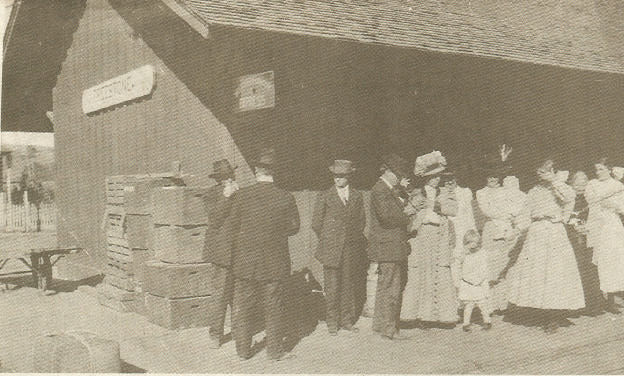 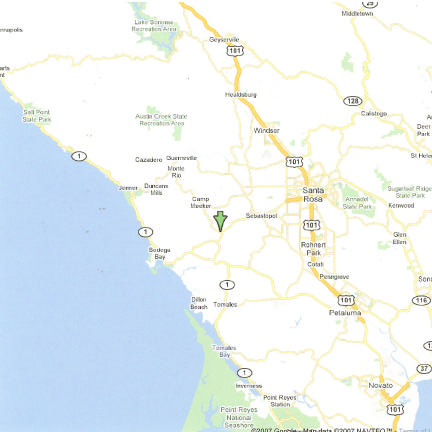 In 1998, the Phelps family (known for their Napa Valley meritage, Insignia) purchased 55 acres in Freestone and planted 40 acres to Pinot Noir and 19 acres to Chardonnay at the end of Freestone Flat Road. The Freestone Flat Vineyard was then joined by an additional purchase nearby of the Quail Hill Ranch where additional Pinot Noir is soon to be planted. This vineyard is on a south-facing hillside above the fog line 8 miles in from the Pacific Ocean. Eventually, plantings will total 90-100 acres. The project is a joint partnership between viticulturists Greg Cannon and Phillipe Pessereau, Bill Phelps, Tom Shelton (CEO of Phelps), and winemaker Craig Williams (formerly Williams Selyem). A 40,000 square foot winery in the center of Freestone Flat Vineyard is nearing completion. It is bermed into the hillside and employs gravity-flow via its three level construction. No tastings or tours will be done at the winery due to environmental concerns, but a tasting room is being constructed at the corner of Boehmian Highway and Highway 12 in the old Pastorale Building. The entire project has been fraught with difficulties since the beginning. They principals have spent at least $25 million dollars to date, including a reported $1 million to obtain the necessary permits and pacify local residents. Gophers have been a major challenge and were eating 40% of the new plantings until seven gopher-trappers were hired to eradicate the gophers. Ripening grapes properly in this chilly climate has been a challenge and yields can be ridiculously low due to poor berry set in the cool days of the spring growing season. It is not unusual to have 45 degree temperature swings in a single day here! It is unclear what the final label name will be (Phelps owns the rights to the name Freestone). The first vintage of Pinot Noir produced from Sonoma Coast grapes has been released as the 2004 fogdog Pinot Noir. Fog dog is a bright or clear spot that appears in a breaking fog. This wine contains grapes from three estate-grown vineyards: 70% Freestone, 26% Quarter Moon, and 4% Ferguson. It was aged in 40% new and 60% 1 to 3 year-old oak barrels. (Don’t confuse the name with Radog, a Central Coast Pinot Noir). The wine is distributed to fine wine retail stores.
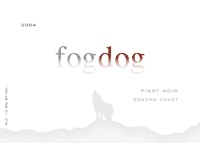 2004 fogdog Sonoma Coast Pinot Noir 13.8% alc., $30. · The wine takes a while to open as the natural carbon dioxide present dissipates. The nose is unusual featuring pepper, wet leaves, dark chocolate and even exotic wood aromas. Red fruits, particularly cherries, are noteworthy. The finish is short and clean. The big acid spine screams for food.
Sonoma Coast VineyardsJohn and Barbara Drady founded this label. John is a reserve-duty Gold Ridge Sonoma fireman who wears many hats including assisting with winemaking, marketing the Sonoma Coast Vineyards portfolio of wines, and tending to his pet side project, Fire Engine Red Zinfandel and Syrah wines (a portion of the profits from which support Sonoma County firefighters). Barbara is well known in wine circles for her company, Affairs of the Vine, which conducts educational wine tastings for corporations and other groups, offers several weekend “Wine Boot Camps” where wine enthusiasts can obtain some hands-on grape farming and winemaking experience, and directs the yearly “Pinot Noir Shootout and Summit” in San Francisco. She has developed a trained and exquisite palate from her many prior years in the retail wine business, and her opinions lend great sophistication to the Sonoma Coast Vineyards wines. The vineyards selected for Sonoma Coast Vineyards wines are situated within a 3-4 mile radius of Freestone and are complemented by vineyards in the Two Rock area on the far southwestern reaches of the Sonoma Coast. Barbara likes to refer to the true Sonoma Coast as “living on the edge.” She offers the following distinctions that typify the true, or as she calls it, the extreme Sonoma Coast: (1) Production limited by temperature, (2) Temperatures which are marginal for ripening, (3) Long growing seasons, (4) Vines that produce grapes with mature fruit at lower sugar levels, (5) Crop loads that are very small, and (6) Thin, rocky, shallow soils that have not been farmed previously and are framed within a very cool climate. Sonoma Coast Vineyard’s inaugural vintage was 2002. This was winemaker Anthony Austin’s 28th vintage. A University of California Davis graduate in enology, Anthony studied under the great Andre Tchelistcheff. He directed the first crush at Firestone in 1976. Firestone was the first modern-day commercial winery in the Santa Barbara region. The Firestone family in partnership with Suntory Limited of Japan spent $7.5 million dollars (a sizable sum at the time) to build a 40,000 square foot winery north of Santa Ynez. By 1978, Firestone Chardonnay had won a Double Gold in a prestigious London wine competition and multiple awards followed under Austin’s direction. In 1981, Anthony left to establish his own label, Austin Cellars, in Los Olivos. He made two legendary Pinot Noirs in 1982, a Sierra Madre Vineyard and a Bien Nacido Vineyard Pinot Noir. The winery was sold in 1992 after one of Austin’s partners was convicted of dealing cocaine to help bankroll the winery. I recently spent some time with John Drady and Anthony Austin as they drove me around the Freestone area pointing out the landmarks and significant vineyards. We saw the Phelps Freestone vineyard and new winery construction. Later, we walked the Ballistreri Vineyard, which provided grapes for Sonoma Coast Vineyards’ first vineyard-designate Pinot Noir in 2004. The pastoral scene was charming, with sheep grazing in a newly planted portion of the vineyard dining on weeds on a brisk morning in December (photo below). Anthony pointed out that the region contained many microclimates with markedly different terroirs. The Ballisteri Vineyard sits in the fog line, but winds at the site blow off the fog regularly opening the vineyard to the sun. 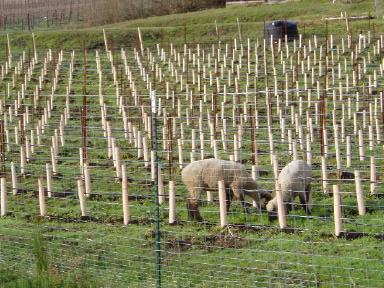 The three of us returned to the Drady residence in Sebastopol and tasted the 2004 Sonoma Coast Vineyard Pinot Noirs.
2004 Sonoma Coast Vineyards Sonoma Coast Pinot Noir 14.23% alc., 1043 cases, $60 was released in January, 2007. It is composed of grapes from 6 vineyards (60% Freestone area) and 7 French clones including Pommard 3, 113, 114, 115, 667, 777, and 828. · It is still un-evolved at this stage. I find that the Drady’s Pinot Noirs take at least a year after purchase to really strut their stuff. The 2003 is just now coming into its own (see page 7), Still, the pedigree is evident. There are copious and dense dark Pinot fruits, some earthiness and mushrooms lurking and a lush texture with a strong but but sensible tannic structure.
2004 Sonoma Coast Vineyards Ballisteri Vineyard Pinot Noir 14.37% alc., <200 cases, $100. Will not be released until the summer of this year. I wanted to get my hands on some of this now. The wine is from the Ballistreri Family vineyard, Freestone View Block , consisting of Dijon clones 114, 115, 667, 777, and 828. · Still tight like its estate brethren, the aromatics attack the senses with wondrous Pinot extracts. It is fat in the mouth with dark stone fruit, game and soy flavors accented by healthy tannins and an explosive finish. The generous acid backbone portends a long life.
You may still find some of the 2002 and 2003 vintage for sale on the Sonoma Coast Vineyard website (www.sonomacoastvineyards.com) and at fine retail wine stores. The prices may seem high, but you must remember that grapes are expensive to farm in the Freestone area of the Sonoma Coast. In addition, the Sonoma Coast Vineyard Pinot Noirs spend extended time in barrel (19 months in 50% new French oak) and in bottle before release. Many Pinot Noirs are rushed to market before they are ready. A number of 2005 Pinot Noirs have been out since mid-summer. The Drady’s passion for fine wine allows them no shortcuts and they are fanatical about the quality.
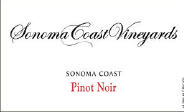 2002 Sonoma Coast Vineyards Sonoma Coast Pinot Noir 14.28% alc., 715 cases, $60. · Deep plum, blackberry and black cherry aromas set the stage for an onslaught of dark fruit flavors highlighted by herbs, wet earth and oak. Easy to drink, and Burgundian in spirit, this Pinot has the right balance of acid and dusty tannins to complement food.
2003 Sonoma Coast Vineyards Sonoma Coast Pinot Noir 14.16% alc., 783 cases, $60. · This was very sexy juice when young and now it is totally scandalous. Full bodied in texture and lush, this smells like earthy mushrooms and dark cherries. In the mouth there are plush ripe berry flavors that carry over into a finish that lasts an eternity. This wine has plenty of structure for the long haul. It builds in intensity over time in the glass which is a sign of a great wine. Still good the next day from an opened bottle.
Besides their Pinot Noirs, Sonoma Coast Vineyards has two other wines of great interest. The Chardonnay is a node to Chablis and an excellent example of this style. The Hummingbird Hill Vineyard (photo below) Sauvignon Blanc preserves its varietal purity by partially fermenting the wine in aged French oak and partially cold fermenting it in stainless steel. Sommeliers have loved this wine and it is poured by the glass at some notable Bay Area restaurants. Sonoma Coast Vineyards wines enjoy a good retail distribution and are also available through the website. For the complete experience, visit John and Barbara at their tasting room in their residence in Forestville (707-874-1993). You cannot help be caught up in their enthusiasm for their wines. Look for them pouring at the 2007 World of Pinot Noir in Shell Beach, California. 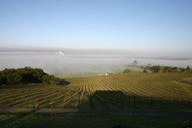
Some Other Enjoyable Sonoma Coast Pinots
2005 Hartford Court Land’s Edge Vineyards Sonoma Coast Pinot Noir 14.5% alc., $35, This Pinot Noir is sourced from the estate Land’s Edge Vineyard near Annapolis in the true Sonoma Coast. The grapes here are picked in miniscule levels often as late as November. The wine is aged for 11 months in 50% new French oak. The clones are 115, 667 and 777. · Nothing really stands out with this Pinot Noir but it is perfectly fine. There is plenty of toast, cherry and wild flowers in the nose. As it opens with air time, it gets better and better with more structure, Attractive tangy red cherry flavors with dark caramel develop that persist on the back end. The mouth feel is rich and the tannins perfectly assimilated.
Hartford Family Wines is located in the Russian River Valley at 8075 Martinelli Road in Forestville. Eight Pinot Noirs are produced, with the single vineyard designates labeled as Hartford Court. The tasting room is open from 10-4:30 daily. The wines may be purchased from the website at www.hartfordwines.com.
 2004 Brogan Cellars Summa Vineyard Young Vine Sonoma Coast Pinot Noir 14.1% alc., $60. · This baby is a deep dark purple color. The aromas of toasty oak and plump dark cherries waft in the glass. The body of the wine is rich and offers dark black cherries, earth and sage. The smooth finish is outrageous. This is a big wine that is beautifully composed and complete in every way. Delightful!
Brogan Cellars wines are crafted by Margi Wierenga, Burt Williams’ (Williams Selyem) daughter. The Pinot Noirs are made from premium vineyards in the Sonoma Coast, Russian River Valley, and Anderson Valley appellations. Production is limited to 1,500 cases and most of the wine is sold through a mailing list (sign-up on the website at www.brogancellars.com). A tasting room is open by appointment at 3232B Dry Creek Road, Healdsburg 95448 (707-473-0211).
2005 Del Dotto Vineyards Cinghiale Vineyard Sonoma Coast Pinot Noir $75. Del Dotto has quickly become one of the hottest visitor sites in Napa Valley. The winery’s caves, first dug in 1885, have been lovingly restored and the winery offers a candle lit cave experience and barrel tasting by reservation for a small charge. Del Dotto owned 400 acres of vineyards to which 96 are planted to vines. In 2005, an additional 359 acres were purchased in the true Sonoma Coast overlooking the Pacific Ocean. The vineyard, named Cinghiale (Italian for wild boar), was previously owned by W.H. Smith. About 35 acres are planted to Pinot Noir. The 2005 is the inaugural release. I had this wine at Cole’s Chop House in the town of Napa. This is a first-rate steak house that has won Zagat’s top rating for a steak house in the Bay Area three years running. I knew Del Dotto was known for Cabernet Sauvignon and other hearty red varietals, so I was surprised to see their Pinot Noir on the list. · The wine was very good. It was a very elegant styled Pinot with nicely balanced Pinot fruits, suede-like tannins, and crisp finishing acidity. It was just fine with steak.
Del Dotto Vineyards is located at 1055 Atlas Peak Rd, Napa, 94558. The phone is 707-256-3332 and the website is www.deldottovineyards.com. The Pinot Noir is only for sale to VIP wine club members.
Appellations of Sonoma CountyAppellations on wine labels indicate where the grapes were grown. Some appellations are more specific than others, with some having a distinctly identifiable and unique combination of terrain, soil, and climatic conditions. Sonoma County stretches from the Pacific Coast in the west to the Mayacamas Mountains in the east and from Mendocino County in the north to Marin and Napa counties in the south. The map below shows 12 of the appellations of Sonoma County. The appellation that is not depicted is the Northern Sonoma AVA which includes several of the other AVAs and encompasses everything in Sonoma County north of Santa Rosa. This appellation exists for no other reason than to allow wineries with vineyards in multiple appellations to label their wines as “estate bottled.” By Federal definition, a winery must be located in the same appellation as the vineyards to use the estate bottled designation. The western Sonoma County AVAs are Pinot Noir country. Referring to the map below, they include Sonoma Coast (lime green, 7,000 acres/5 wineries), Russian River Valley (turquoise blue, 10,000 acres/50 wineries), Green Valley (brown, 1,200 acres/10 wineries), and Sonoma Carneros (pink, 8,000 acres/22 wineries). The eastern Sonoma County AVAs include Rockpile (orange, 200 acres), Dry Creek Valley (purple, 10,000 acres/28 wineries), Chalk Hill (bright green, 1,000 acres/5 wineries), Alexander Valley (yellow, 15,000 acres/28 wineries), Knight’s Valley (blue, 2,000 acres/2 wineries), Bennett Valley (dark blue, 850 acres/2 wineries), Sonoma Valley (dark green, 13,000 acres/42 wineries), and Sonoma Mountain (dark orange, 800 acres/3 wineries). Some Pinot Noir is grown in specific sites in the Sonoma Valley and Sonoma Mountain appellations. If an AVA is named on a label, at least 85% of the wine’s grapes must originate from that AVA.
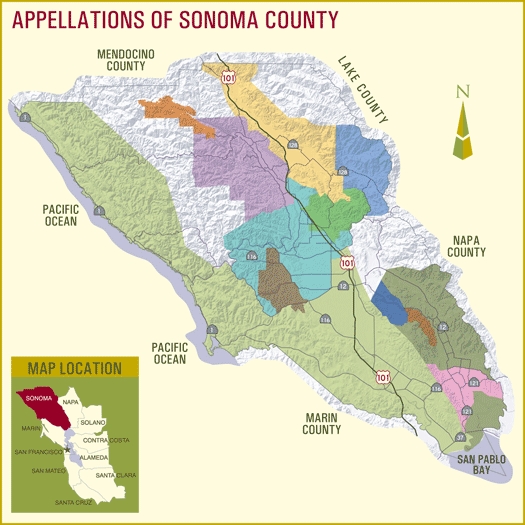
Tony SoterTony Soter has left the Napa Valley to devote himself full-time to his Soter Vineyards label in the Willamette Valley. He wants to concentrate on developing his Mineral Springs Pinot Noir Vineyard. He will continue to consult for Napa Carneros winery Etude, but Etude will be under the direction of winemaker Jon Priest on a day to day basis.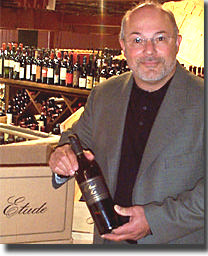
Oregon Pinot Thrill or Overkill?Oregon winemakers and Georg Riedel have spent two years in research, evaluation, and comparative tastings to design a new shape of wine glass especially for Oregon Pinot Noir. The idea sprang from a conversation between International Pinot Noir Celebration Executive Director Amy Wasselman and Georg Riedel. In a workshop format, winemakers, wine writers, and sommeliers evaluated a number of Riedel glasses. The Vinum Extreme was found to focus the beautiful aromas of Oregon Pinot Noir, but on the palate, the Grand Cru Burgundy glass was the clear winner. The Grand Cru glass highlighted the velvety texture of Oregon Pinot Noir and softened the edges of younger wines. After preliminary tastings, a number of Oregon’s best Pinot Noirs were shipped to Austria for Georg Riedel to work with at his facility. The final glass chosen was a large-bowled, tulip-shaped glass that glares out at the top.  This glass was presented along with eleven others in a subsequent workshop. Tasters agreed that the slight flared opening of this glass seemed to focus aromas and its flared lip reproduced the mouth-feel tasters had experienced with the Grand Cru Burgundy glass. The glass will be officially unveiled at this summer’s International Pinot Noir Celebration in McMinnville, Oregon on July 27-29, 2007. For details phone 800-775- IPNC or consult the website at www.ipnc.org. A picture of the new stem was not available at press time. |